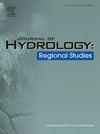An integrated framework for prediction and sensitivity analysis of water levels in front of pumping stations
IF 4.7
2区 地球科学
Q1 WATER RESOURCES
引用次数: 0
Abstract
Study region: The South-to-North Water Diversion Eastern Route Project section from the Nansihu-Dongpinghu pumping station cluster.
Study focus: An integrated framework for prediction and sensitivity analysis of water levels in front of pumping stations is proposed to obtain more accurate predictive surrogate models and to simplify surrogate model inputs. The results show that among the three different water transport models, the Firefly-Support Vector Machine model has a smaller mean absolute error (<2.38 %), root mean square error (<4.76 %), and mean absolute percentage error (<0.07 %) with higher linear correlation (>0.85). The Firefly-Support Vector Machine model is more suitable for water level prediction than other models. The water level in front of the target pumping station and the t-ahead flow were the most sensitive parameters, and the longer the foresight period, the higher the importance.
New hydrological insight for the region: Three water transportation modes are proposed according to the characteristics of regional hydrological connectivity in the long-distance water transportation system. This enables the water level prediction surrogate model to adapt to the complex connectivity of pumping stations and lakes in the region, improving the accuracy of water level prediction. Subsequently, the parameter sensitivity of the water level prediction surrogate model for each water transport mode was also tested.
求助全文
约1分钟内获得全文
求助全文
来源期刊

Journal of Hydrology-Regional Studies
Earth and Planetary Sciences-Earth and Planetary Sciences (miscellaneous)
CiteScore
6.70
自引率
8.50%
发文量
284
审稿时长
60 days
期刊介绍:
Journal of Hydrology: Regional Studies publishes original research papers enhancing the science of hydrology and aiming at region-specific problems, past and future conditions, analysis, review and solutions. The journal particularly welcomes research papers that deliver new insights into region-specific hydrological processes and responses to changing conditions, as well as contributions that incorporate interdisciplinarity and translational science.
 求助内容:
求助内容: 应助结果提醒方式:
应助结果提醒方式:


